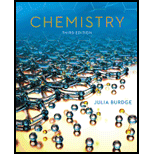
Concept explainers
Which of the following processes is accompanied by an increase in entropy? (Select all that apply.)
Interpretation:
The processes accompanied by an increase in entropy are to be determined.
Concept introduction:
Entropy is the measure of randomness in a thermodynamic system. The second law of thermodynamics states that the entropy of an isolated system never decreases. Such systems spontaneously evolve towards thermodynamic equilibrium, the state with maximum entropy.
The processes in which entropy increases are called endothermic processes.
The processes in which entropy decreases are called exothermic processes.
Answer to Problem 1KSP
Correct answer:Options (a) and(c).
Explanation of Solution
Reasons for the correct options:
The reaction is shown below:
In the given reaction, bromine changes from the liquid state to the gaseous state. In the conversion of a liquid to its gaseous state, the volume occupied by the molecules increases. The particles are no longer locked in a place. Because they are now free to move, they can distribute themselves in more ways. Gases have the highest entropy values because they have the greatest freedom of movement. Therefore, the entropyfor this process increases.
The reaction is shown below:
In the given reaction, solid sodium chloride is converting into its gaseous state. When a solid gets converted into thegaseous state, the molecules are free to move, due to which the distribution of energy increases and hence, entropy increases.
Hence, options(a) and(c) are correct.
Reasons for the incorrect option:
The reaction is as follows:
The given reaction is option (b). It is incorrect because in this reaction, entropy decreases as the gaseous state gets converted to the solid state, that is, the volume occupied by molecules is decreasing. The particles in solid state are locked in place and highly ordered. So, it is an incorrect answer.
The reaction is as follows:
The given reaction is option(d). It is incorrect because in this reaction, entropy decreases as the gaseous state gets converted to theliquid state, that is, the volume occupied by molecules is decreasing. So, it is an incorrect answer.
Hence, options (b) and (d) are incorrect.
Want to see more full solutions like this?
Chapter 13 Solutions
Student Study Guide for Chemistry
- Determine the vapor pressure of benzyl alcohol at 462.3 K in Pa.arrow_forwardIn a typical cold pack (used for sports injuries), a salt such as ammonium nitrate is kept in a separate pouch from a bag of water. When the pouch is punctured, the salt readily dissolves in the water, and the pack becomes noticeably cooler to the touch (temperature decreases from room temp to about 5 oC). Based around le Charlier principle conclude the signs for ΔHº, ΔSº, and ΔGº for the solvation of ammonium nitrate in water.arrow_forwardIn a system where 1 particle can move between 3 states or 1 particle that can move between 5 states? Explain which system will have a greater disorder.arrow_forward
- Hexane and heptane are miscible with eachother in all proportions. In making a solution of them, isthe entropy of the system increased, decreased, or close tozero, compared to the separate pure liquids?arrow_forwardAnother metal phosphate is cobalt(III) phosphate. It will behave similar to calcium phosphate in an acid solution, and will form an equilibrium between reactants and products. What is the net ionic equation including phases for CoPO4(s) dissolving in H3O+(aq) ?arrow_forwardjust to verify the answer rto 1 is increasing and 2 is increasing>??arrow_forward
- The reaction C6H12O6 + 6O2 → 6CO2 + 6H2O ΔHo = −1072 kJ/mol and ΔSo = 578 J/K.mol. What is the standard Gibbs free energy charge for this reaction (in kJ/mol) at 37oC?arrow_forwardDuring the industrial synthesis of methanol (CH3OH), carbon monoxide (CO) reacts with hydrogen gas. For methanol, ΔH= -100.4 kJ/mol. a. Write the balanced chemical equation for this reaction. b. Is it preferable to maintain this system at high or low pressure? Explain.arrow_forwardEstimate whether theentropy of the system increases or decreases during eachprocess: (a) photodissociation of O2(g), (b) formation ofozone from oxygen molecules and oxygen atoms, (c) diffusionof CFCs into the stratosphere, (d) desalination ofwater by reverse osmosis.arrow_forward
- In the laboratory, hydrogen chloride (HCl(g)) and ammonia (NH3(g)) often escape from bottles of their solutions and react to form the ammonium chloride (NH4Cl(s)), the white glaze often seen on glassware. Assumingthat the number of moles of each gas that escapes into the room is the same, what is the maximum partial pressure of HCl and NH3 in the laboratory at room temperature? (Hint: The partial pressures will be equal and are at theirmaximum value when at equilibrium.)arrow_forward10.0 mol PCl3(g), 20.0 mol Cl2(g), and 40.0 mol PCl5(g) are introduced in a previously evacuated 10.0-L vessel at 25.0oC. The KP for the reaction at this temperature is 1.47×10–7: PCl5(g) →← PCl3(g) + Cl2(g), KP= 1.47×10–7 What is the immediate Gibbs free energy change for the reaction? In what direction the reaction will spontaneously approach equilibrium? Enter your answer with correct units and significant figures, and check the correct box below: Reaction proceeds spontaneously forward towards equilibrium. Reaction is at equilibrium. Reaction proceeds spontaneously backward towards equilibrium.arrow_forwardformation of solutions where the process is endothermic can be spontaneous provided that 1. they are accompanied by another process that is exothermic 2. they are accompanied by an increase in order 3. they are accompanied by an increase in disorder 4. the solvent is a gas and the solute is a solid 5. the solvent is water and the solute is a gasarrow_forward
 Principles of Modern ChemistryChemistryISBN:9781305079113Author:David W. Oxtoby, H. Pat Gillis, Laurie J. ButlerPublisher:Cengage Learning
Principles of Modern ChemistryChemistryISBN:9781305079113Author:David W. Oxtoby, H. Pat Gillis, Laurie J. ButlerPublisher:Cengage Learning Chemistry: Principles and ReactionsChemistryISBN:9781305079373Author:William L. Masterton, Cecile N. HurleyPublisher:Cengage Learning
Chemistry: Principles and ReactionsChemistryISBN:9781305079373Author:William L. Masterton, Cecile N. HurleyPublisher:Cengage Learning

